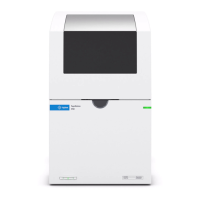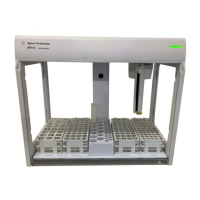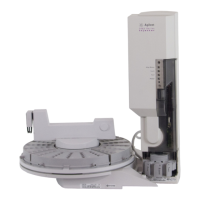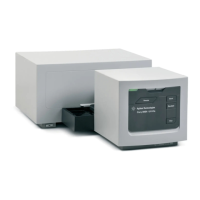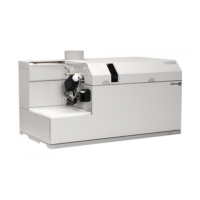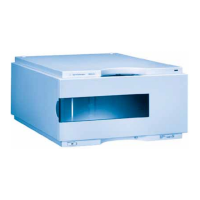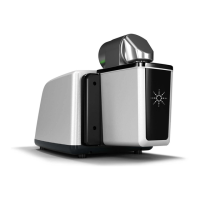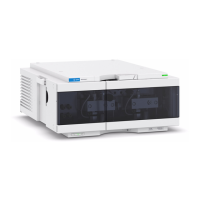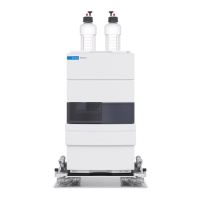Do you have a question about the Agilent Technologies 4107 and is the answer not in the manual?
General safety information for operating the nitrogen generator and potential hazards to personnel and equipment.
Details the requirements for a clean, dry, oil-free air supply and associated cautions.
Discusses hazards of compressed gases, ventilation, and potential asphyxiation risks.
Information regarding the electrical safety of the nitrogen generator and its power supply.
Guidance on consulting compressor manuals for safety information and operator-accessible parts.
Guidance on handling the nitrogen generator's weight and using appropriate lifting devices.
Explains the meaning of various warning symbols found in the documentation and on the instrument.
Details the generator's compliance with EU Electromagnetic Compatibility and Low Voltage Directives.
Defines symbols for direct current, CE, CSA/UL, Korean EMC, ACMA, and WEEE.
Information on Class A equipment requirements for electromagnetic compatibility and interference mitigation.
Statements on Class A suitability and compliance with Canadian ICES-001 for ISM devices.
Details the environmental and operating requirements for the MP-AES instrument and nitrogen generator.
Lists the available documentation for setting up and operating the Agilent 4107 Nitrogen Generator.
Explains the purpose of 'Note' for advice/information and 'Tip' for practical hints.
Highlights that installation must be done by trained personnel and site preparation is required.
Warns about the heavy weight of the generator and the need for lifting devices to prevent injury.
Identifies components like power button, regulators, and connectors on the front and side of the generator.
Identifies components on the rear of the generator, including power and output connections.
Caution regarding potential irreparable damage if operated without proper inlet air quality and filtering.
Step-by-step instructions for unpacking the nitrogen generator from its pallet packaging.
Instructions for lifting the generator using slings and moving it into position.
Diagram showing air supply hose, filtered air supply input, power input, and nitrogen output.
Steps to connect the nitrogen generator to the air supply using the provided hose and fitting.
Instructions for connecting the nitrogen output to the MP-AES instrument or EGCM.
Diagram illustrating the nitrogen inlet ports on the MP-AES instrument.
Diagram showing the nitrogen inlet connection on the External Gas Control Module (EGCM).
Steps for connecting the DC output connector and AC supply cable to power the generator.
Ensures safety practices and laboratory setup are complete before starting the nitrogen generator.
Step-by-step guide to powering on the nitrogen generator and checking initial settings.
Information on generator operating status, power indication, and caution on using unpurged gas.
Instructions to select the nitrogen generator for use within the MP Expert software configuration.
Procedure for purging the nitrogen generator to achieve the required nitrogen gas purity.
Guidance on when and how to turn off the nitrogen generator for short or long idle periods.
Steps to safely depressurize the nitrogen generator before disconnecting hoses or replacing filters.
Warning about eye hazards from rapid gas escape and the need for safety goggles during depressurization.
Overview of maintenance requirements that can be performed by the operator.
Guidance to refer to instrument guides for MP-AES maintenance and MP Expert Help for accessories.
Lists routine maintenance tasks for daily, monthly, and yearly intervals, including filter checks and leak tests.
Step-by-step instructions for draining accumulated liquid from the filter housing.
Diagram indicating the location of the screw for filter housing removal.
Identifies the three filter types and cautions against interchanging them due to potential damage.
Illustrates the process of removing the gas filter housing.
Instructions for unscrewing and replacing filters, and repeating for each filter.
Steps for testing connections for leaks using leak testing solutions or electronic detectors.
Warning about eye hazards from pressurized gases and the need for protective eyewear during maintenance.
Lists recommended spare parts like filter kits and hose kits for minimizing downtime.
Guidance to refer to the Agilent Technologies website for technical support contact details.
General safety information for operating the nitrogen generator and potential hazards to personnel and equipment.
Details the requirements for a clean, dry, oil-free air supply and associated cautions.
Discusses hazards of compressed gases, ventilation, and potential asphyxiation risks.
Information regarding the electrical safety of the nitrogen generator and its power supply.
Guidance on consulting compressor manuals for safety information and operator-accessible parts.
Guidance on handling the nitrogen generator's weight and using appropriate lifting devices.
Explains the meaning of various warning symbols found in the documentation and on the instrument.
Details the generator's compliance with EU Electromagnetic Compatibility and Low Voltage Directives.
Defines symbols for direct current, CE, CSA/UL, Korean EMC, ACMA, and WEEE.
Information on Class A equipment requirements for electromagnetic compatibility and interference mitigation.
Statements on Class A suitability and compliance with Canadian ICES-001 for ISM devices.
Details the environmental and operating requirements for the MP-AES instrument and nitrogen generator.
Lists the available documentation for setting up and operating the Agilent 4107 Nitrogen Generator.
Explains the purpose of 'Note' for advice/information and 'Tip' for practical hints.
Highlights that installation must be done by trained personnel and site preparation is required.
Warns about the heavy weight of the generator and the need for lifting devices to prevent injury.
Identifies components like power button, regulators, and connectors on the front and side of the generator.
Identifies components on the rear of the generator, including power and output connections.
Caution regarding potential irreparable damage if operated without proper inlet air quality and filtering.
Step-by-step instructions for unpacking the nitrogen generator from its pallet packaging.
Instructions for lifting the generator using slings and moving it into position.
Diagram showing air supply hose, filtered air supply input, power input, and nitrogen output.
Steps to connect the nitrogen generator to the air supply using the provided hose and fitting.
Instructions for connecting the nitrogen output to the MP-AES instrument or EGCM.
Diagram illustrating the nitrogen inlet ports on the MP-AES instrument.
Diagram showing the nitrogen inlet connection on the External Gas Control Module (EGCM).
Steps for connecting the DC output connector and AC supply cable to power the generator.
Ensures safety practices and laboratory setup are complete before starting the nitrogen generator.
Step-by-step guide to powering on the nitrogen generator and checking initial settings.
Information on generator operating status, power indication, and caution on using unpurged gas.
Instructions to select the nitrogen generator for use within the MP Expert software configuration.
Procedure for purging the nitrogen generator to achieve the required nitrogen gas purity.
Guidance on when and how to turn off the nitrogen generator for short or long idle periods.
Steps to safely depressurize the nitrogen generator before disconnecting hoses or replacing filters.
Warning about eye hazards from rapid gas escape and the need for safety goggles during depressurization.
Overview of maintenance requirements that can be performed by the operator.
Guidance to refer to instrument guides for MP-AES maintenance and MP Expert Help for accessories.
Lists routine maintenance tasks for daily, monthly, and yearly intervals, including filter checks and leak tests.
Step-by-step instructions for draining accumulated liquid from the filter housing.
Diagram indicating the location of the screw for filter housing removal.
Identifies the three filter types and cautions against interchanging them due to potential damage.
Illustrates the process of removing the gas filter housing.
Instructions for unscrewing and replacing filters, and repeating for each filter.
Steps for testing connections for leaks using leak testing solutions or electronic detectors.
Warning about eye hazards from pressurized gases and the need for protective eyewear during maintenance.
Lists recommended spare parts like filter kits and hose kits for minimizing downtime.
Guidance to refer to the Agilent Technologies website for technical support contact details.
| Brand | Agilent Technologies |
|---|---|
| Model | 4107 |
| Category | Laboratory Equipment |
| Language | English |

